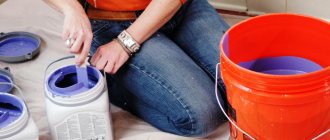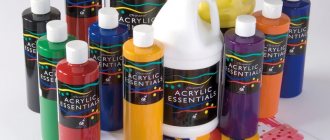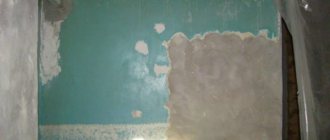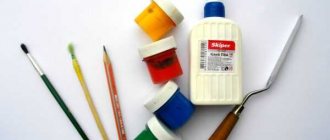Home » Domestic auto industry
1 minute to read. Updated 08/04/2019
To apply oil paint to a surface, sometimes it is necessary to obtain a more liquid consistency, so it becomes necessary to dilute the composition. This procedure will also be required in cases where the solution was left for some time in an unsealed container, which led to its hardening. To dilute the mixture, various substances are used, which are selected based on the purpose of the paint.
How to dilute oil paint?
When choosing a solvent, pay attention to the purpose for which the paint is intended. The fact is that this type of material includes two large groups, divided by area of application:
1. Solutions used for painting surfaces of residential or commercial premises. Traditional compositions, which are presented in abundance on the shelves of hardware stores, are suitable for these purposes. Although recently the demand for these products has decreased, in certain situations an oil solution can be the optimal solution.
This mixture must be diluted in the following cases:
- The material is too thick.
- A base layer needs to be laid.
- Painting is done on wood. A composition that is not too thick fits well on such a base, otherwise it will not be possible to achieve strong adhesion.
- Woody. It is made from the bark and branches of trees containing an abundance of resin. The initial solution is dark, but after processing it becomes transparent.
- Turpentine. It is obtained by distilling the resins of living coniferous trees and is an essential oil. It has many positive properties, so its scope of use is much wider than its use as a solvent.
Attention! The mixture has a specific odor, so it is recommended to carry out work in a ventilated area.
White Spirit
Turpentine can be successfully replaced with white spirit. The demand and popularity of these products is explained by their wide distribution and availability. In addition, there are varieties on sale that do not have a strong unpleasant odor.
The work process when using such a composition is very convenient. The mixture does not evaporate as quickly as other solvents, which allows you to paint without haste. Also, white spirit when added does not change the color of the composition.
Solvent
This thinner for oil paints has the number 647. Product designation may vary and depends on the components included. It is not recommended to use solvent number 646 due to the presence of acetone in it.
It is not always easy to dilute oil paint with this substance: excess leads to a deterioration in the properties of the product.
Gasoline and kerosene
These options are recommended for use in the absence of other mixtures and only for outdoor use. A significant drawback of the solutions is the specific smell, which can cause dizziness and poisoning. This is due to rapid evaporation. But kerosene is the best solution when you need to dilute an old composition that has become very thick.
Drying oil
This is a universal solution; besides, drying oil is included in oil paints. But it must be taken into account that the diluent must correspond to the type of substance that is included in the coloring material.
To obtain the necessary information, you need to pay attention to the labeling of painting mixtures. The following designations are distinguished:
- PV-024. Such products are made on the basis of pentaphthalic drying oils.
- MA-021. The composition includes natural drying oil, which contains more than 95% vegetable oils.
- GF-023. Produced with the addition of glyphthalic drying oil. It is an alternative to natural.
Correct identification of components helps to obtain the desired result.
How to dilute PF-115 enamel
If you decide to paint your car with PF 115 paint, be patient and take several tools. Remember that you should not apply the substance to the surface without thoroughly preparing it. In addition, when you open the can, you may find that the paint is too thick - then you will have to thin it. The choice of solvent must be taken very carefully - the wrong thinner can not only not bring any results, but also ruin the paint.
Dilution procedure
No less important is the process of diluting the paint yourself, because its accurate implementation is the key to the absence of further problems.
Activities are carried out in the following order:
- The container of paint is opened, the thickness is assessed and thorough mixing is performed. To do this, use a handy tool or a prepared clean stick.
- The required proportion is determined. For each solvent, the indicator may be different. The exact amount of the substance depends on the thickness of the paint, but should not exceed 5% of the total mass. Although, if necessary, obtain a mixture for the base layer or primer of walls, the volume of white spirit and drying oil can reach up to 10%. To dilute the mixture in the best possible way, the thinner is added directly to the jar. It should be poured in gradually in small portions. This will allow you to restore the composition and mix it well.
- Next, the paint is poured into containers for use. During the painting process, the material may thicken, so you need to periodically mix the solvent.
It is more difficult to thin paint that has been left open for a while. Work order:
- The film that has formed on the surface due to exposure to oxygen is carefully removed. You cannot leave it or mix it, otherwise it will be impossible to completely get rid of hard lumps.
- A small amount of kerosene mixed with white spirit is poured into the container, everything is mixed well. If required, more thinner is added.
- Then you can paint with this mixture or wait until the kerosene evaporates and use only one component for dilution.
Important! The work is carried out in compliance with increased precautions, since oil paint and all substances used for dilution are flammable and toxic.
How to paint a car with PF 115 enamel
Painting a car is an extremely important task, so take it very seriously.
- Preparing for work. First of all, clean the surface of the machine from dust. If you start applying enamel to a dirty car, it will look extremely unpresentable.
- Sanding. After getting rid of road dust and rust, treat the car with sandpaper. For thorough sanding, fine-grained sandpaper is ideal - coarser paper can seriously damage the surface of the car. If the coating does not become very smooth, use drying oil.
Stages of car painting
- Primer. After making sure that there are no bumps or scratches left on the surface of the car, feel free to proceed with the primer. Many car enthusiasts choose primer in spray bottles rather than in jars - this way the substance is better applied and fixed more reliably. In most cases, one layer of soil is sufficient. Remember that the primer needs to dry thoroughly, so wait ten to fifteen minutes before applying the alkyd enamel.
- Dilution of paint. Remember that under no circumstances should you use water that is used to dilute acrylic enamel. It is much more reasonable to use white spirit - this is the solvent that the manufacturers of PF 115 themselves use. Please note that this thinner should be stored in a tightly closed container away from sunlight. Remember that this substance is gasoline, so do not open or pour it near a source of heat or fire.
How to thin oil paint for application with different tools
Using different tools to paint walls, ceilings or other substrates involves diluting the composition to the desired viscosity level. At home, this parameter is determined using a simple device - a viscometer, which can be purchased in a store.
The device is a funnel with a nozzle, which can be of different sizes. Based on the period of time during which the poured composition flows through the hole, the viscosity level is determined in seconds.
The process looks like this:
- After adding the solvent to the paint container and mixing, the viscometer is immersed in it.
- A stopwatch is prepared in advance. You can use any other device.
- The device is removed from the composition, and the timer is turned on at the same time.
- After the mixture completely empties the glass (funnel) of the device, the stopwatch turns off. The value is fixed.
To paint the surface with brushes and a roller, the viscosity should be at the level of 10–15 seconds, and for a spray gun – 25–30 seconds, depending on the model.
The content of the article
Composition and technical characteristics
In terms of its structure, the enamel belongs to pentaphthalic suspensions, as indicated by the markings. The basic composition includes the following components:
- titanium dioxide;
zinc white;
iron glaze;
carbon black.
In addition, coloring pigments are added to the composition, giving the enamel color.
According to Russian GOST
, regardless of the manufacturer,
PF-115
has a number of constant characteristics (see table).
Average paint consumption is 21.5 m 2 /l
.
This indicator depends on many factors. On a rough surface, paint consumption increases by 1.5-2 times
.
Thin the oil paint
Probably everyone can remember a similar incident: during the renovation period, more than once, due to their own carelessness, they forgot to close a can of paint, which, to their great disappointment, caused the material to harden and was no longer suitable for use. Below are examples of possible paint solvents that will help you save thickened paint, or simply dilute new paint.
Oil paints, by themselves, can be either thickly rubbed or immediately have the consistency necessary for their application. Paints, conventionally called “thick”, are used extremely rarely in this form; most often they are diluted with a solvent. Also, already dried paints or those that are planned to be used as a primer are diluted with this specific liquid.
The type of paint solvent is determined according to the properties of the material on which the paint will be applied.
Oil paint can be easily diluted with many chemicals, which are extremely easy to purchase in hardware stores. Examples include the following solvents: turpentine (purified or not), gasoline, solvent 647 kerosene (only with the addition of a drier), white alcohol. However, white alcohol, thinner 647 and turpentine are by far the most widely used types of solvents.
Consumption rates for painting
Enamel consumption depends on many factors, but average values for applying a single-layer coating vary between 150-180 g/m2
. However, these are only approximate standards.
If work is carried out on a hot day, the enamel will evaporate, and accordingly the consumption will increase. If a roller is used when painting, this gives a slight saving in paint, and application through a pneumatic sprayer is guaranteed to exceed the average consumption rate by 1.5-2 times
.
In addition, color can affect consumption: white enamel usually costs much more than black enamel. Professional painters and finishers recommend purchasing enamel at the rate of 1 kg/10 m2 of surface.
White spirit for oil paints
The scope of the same white spirit is extremely wide. It is serious competition for turpentine, whose sales volumes fell after white alcohol appeared on the markets.
White spirit for oil paints is used in the following cases:
- To obtain an organodispersion when diluting paint and varnish coatings.
- For the purpose of diluting varnishes, primers, drying oils, enamels, car preservatives, etc.
- Used for washing brushes after finishing work.
- In order to degrease the surface if this kind of problem suddenly arises.
- Can be used as a solvent for rubber or alkyds.
This solvent is extremely popular due to its availability, because its price is quite reasonable, even taking into account the wide range of its applications.
When using white alcohol, the cost of paint or other type of paint coating is significantly reduced, but the quality of the paint remains unchanged.
If desired, it is even possible to find a type of white alcohol that does not have its characteristic pungent odor.
Rules for using white spirit for oil paints:
- We should not forget about safety precautions, so you should avoid finding solvents near any open flame sources or switches. It is also worth paying attention in advance to the fact that solvents of some compositions can spontaneously ignite under the influence of temperatures.
- You also need to pay attention to the rather pungent odor of the substance. Therefore, paint should be diluted only in well-ventilated areas or even in the open air.
- Due to the chemical composition of solvents, they should not come into contact with the skin or mucous membranes. Otherwise, you must immediately rinse the area where the substance comes into contact with water. Clothes can also be damaged by exposure to strong chemicals.
How to Determine Paint Viscosity Using a Viscometer
To determine the viscosity of paint, varnish or primer, take a viscometer and fill it completely to the brim with the selected material, while closing the hole with your finger, measure the time using a stopwatch, and at the same time open the hole in the viscometer, which was previously kept closed. We follow the stream flowing through the hole. As soon as the stream stops flowing as a single stream and turns into droplets, the stopwatch must be turned off. The time in seconds that is recorded on the dial will be the measured viscosity, indicated in DIN seconds.
For finished paints, the viscosity is indicated on the can or in the technical specifications for the paint and varnish material. However, you should not always trust what is written, sometimes it is worth double-checking this data and after checking, if the data indicated on the can and the calculations carried out using a viscometer differ, for example, the viscosity turned out to be higher than recommended, then such paint will need to be diluted. Sometimes the viscosity of paint is determined “by eye”, however, relatively accurate data in such a determination can only be achieved with extensive experience in painting work.
When diluting paint, measuring rulers and containers are used to maintain proportions. The measuring container is part of the toolkit used to dilute the paint and is a transparent plastic jar on which the proportions are marked using notches. Paint dilution can be done using a regular plastic glass, however, before work it must be checked for resistance to solvent - pour a small part of the specified liquid into it and after a while see if the solvent has leaked out. If everything is in order, no holes have formed in the glass from the chemical substance, then you can safely use this glass for diluting paint.
After thinning the paint, be sure to get rid of insoluble elements and debris. To do this, strain it through a sieve or use gauze folded in several layers as a filter.
Types of paints
1). Water-dispersion paints
Water-based paints and varnishes consist of pigment, water and a material that binds them. This type of paint includes watercolor, gouache and acrylic, which is the most popular and in demand due to its waterproof properties. Acrylic paints are used both indoors and outdoors, dry quite quickly and are considered environmentally friendly. This purity factor is due to the fact that clean, cold water is used to dilute water-based acrylic paints.
2). Oil paints
They are perfect for outdoor use due to the fact that they create a protective layer that does not allow moisture and water to pass through. Oil paints are made from all kinds of essential oils and dyes. That is why, when diluting oil paints, white spirit, drying oil and oil-resin varnish are used.
Enamels are represented by the largest variety on the paint market. This is due to the fact that they can be diluted with almost all solvents: turpentine, white spirit, gasoline, solvent, xylene, solvents R-4, R-6, No. 646 and No. 645.
Turpentine for oil paints
Turpentine is currently a popular paint thinner.
In addition, it is used in the production of rosin, as well as dammar. It can also be found in copal-based varnishes. The composition of turpentine is complex, and in itself it is like an essential oil. Types of turpentine for oil paints:
- Stump turpentine. It is made mainly from the bark of coniferous trees, as well as stumps.
- Wood turpentine. In production, tree branches and bark, which contains resin, are used. In its original form, such turpentine is a brownish liquid, which disappears immediately after repeated processing.
- Turpentine turpentine. This type of solvent can only be compared with real essential oil, since it is obtained by distilling the resin and resinous materials of various types of coniferous trees. The valuable properties of this oil are not lost even after secondary processing, which is its undoubted advantage.
Dilution of artistic paints
Drawing materials can also be of different thicknesses, which requires bringing them to the desired consistency. In addition, the mixture is applied to different surfaces (wooden, fabric). Therefore, oil art paints require a different approach and a list of diluting agents.
Such compositions can be diluted with the following substances:
- Oil. Purified hemp, sunflower or flax oil is suitable for the process.
- Pinen. Its other name is “Thinner No. 4”.
- Multicomponent mixtures. This can be a double and a tee: the first contains varnish and oil, and the second has pinene added to them.
It is recommended to choose the material solely from your own preferences, this will allow you to achieve the desired result. That is why such paints are diluted in proportions that are determined individually after several samples. But it is worth remembering that excess solvent can destroy the structure of the coloring material.
Solvent 647 for oil paints
Solvent 647 is a fairly strong, colorless chemical that is highly flammable and also emits a strong, unpleasant odor, which is quite typical for this type of solvent. This liquid is often used to dilute alkyd enamels and pentaflathein enamels. They are often used to dilute varnishes or putty. The surfaces to be painted are first degreased with a solvent. Various industrial tools and parts are also washed with this liquid, and in addition, solvent 647 is used to clean contaminated fabric.
When diluting paint, you should be extremely careful in its ratio of solvent, since if the amount of solvent is incorrect, the paint can easily be damaged. In diluted form, the paint is used for better penetration into the surface material. A mixture of paint and solvent is also used as a primer.
Mix it well for 10-20 minutes until smooth.
In this article we will talk about paint solvents. The solvent is an organic volatile liquid that is used to give paint-based materials the necessary painting consistency. Therefore, today’s topic for discussion will be a consideration of the types of solvents that need to be used in certain cases, with this or that paint.
Varieties and decoding
Commercially available enamels, based on their composition, are divided into four categories:
- Aerosol
— dry quickly, allowing you to significantly reduce the work process.
Acrylic
— universal compositions for interior and facade work on concrete, plaster and brick.
Alkyd
- for wooden and metal structures.
Heat resistant
- heating radiators and other surfaces exposed to high temperatures.
In addition, enamels differ in markings, which determine the composition of the product.
Each enamel has a specific area of use, which is usually indicated by the manufacturer in the instructions for use.
Solvents for oil paints and varnishes
Petrol
. It is the simplest and most widespread solvent that can be used for oil paints. This is a transparent liquid, which is better known as a fuel for cars - it has a high degree of ignition and a characteristic odor. It is obtained as a result of the distillation of oil. Gasoline is mainly used as a solvent for oil paints and alkyd enamels, as well as varnishes and putties. Less commonly, it is used to dilute pentaphthalic enamels.
In addition, additional functions include degreasing surfaces for applying varnish or paint, as well as dry cleaning of fabrics and washing of parts and tools.
Turpentine
. Also one of the solvents for varnishes and paints. This solvent is a complex mixture consisting of hydrocarbons, mainly terpenes. Turpentine is used as a solvent for oil and alkyd styrene enamels and paints. Also, this substance is used to prepare many varnishes based on copal, rosin, and dammar. By the way, it remained almost the only most common solvent until the advent of white spirit.
White Spirit
. Actually, now let's talk about white spirit. This solvent is used as a substance for diluting most paints - oil and enamel paints, varnishes and other paint and varnish products. It is used for diluting primer or drying oil, bituminous material, putty and car preservatives, for washing hands and hands after using paints, enamels, and so on. Also used for degreasing surfaces.
Additional Information
Binders are an essential component in the production of oil paints. These include oils that, when dry, form a protective film on the surface of the painting. Thanks to her, the paintings of great creators are preserved for centuries.
Thinners for oil paints are used to reduce the viscosity of paints during operation. Terpenes and white spirit are also used for painting.
Those who want to paint need to select the correct pigment number, find a good solvent, select high-quality brushes and treat them with care. Samples of foreign-made solvents are presented on the sales market. This gives the consumer the opportunity to have a wide choice of materials for diluting oil paints.
Oil paint dries on the brush, so it needs to be washed thoroughly when finished. Do not leave brushes in paint. It is important to dry a clean brush to prevent mixing of paints. Also, do not let the paint dry on your hands.
When using oil paints, you must follow the drawing sequence, the rules for using paints and caring for brushes. Paints must be properly prepared using the correct solvents.
Expert advice (2 videos)
Solvents for glyphthalic paints and bitumen varnishes
Solvent
. This solvent is a mixture consisting of aromatic carbohydrates, which contain a small content of naphthenes, as well as paraffins and other cyclic carbohydrates. Solvent is used as a substance for dissolving oils and bitumen, most types of rubbers and oligomers. It is used as a means for diluting polyesteramides and other paints and varnishes that contain a small amount of melamine alkyd materials.
Xylene
. A petroleum product that is used to dissolve electrical insulating paints, varnishes and most enamels, silicone varnishes, as well as epoxy resins. There is one caveat here, since xylene has a third class of hazard for the human body; it is fire and explosive.
What's in it?
The composition of alkyd painting materials largely determines the properties and characteristics of varnishes, paints and primers. In general, any paint and varnish material contains ingredients such as:
- coloring pigments;
- various excipients;
- thinners;
- driers – substances that accelerate drying, etc.
As for alkyd paints, they contain alkyd polymers (resins) as foaming agents . But depending on the type of resin, pentaphthalic and glyphthalic binders are distinguished, and, accordingly, pentaphthalic (marking - PF) or glyphthalic (GF) enamels, primers and varnishes are produced. In addition, on alkyd drying oil, in addition to traditional liquid ones, thickly grated compositions are also produced (GF-013, PF-014, etc.). Enamel painting material, or simply enamel, is a paint with which you can obtain not a matte, but a glossy or even mirror-like surface.
The segment of alkyd materials includes paints having the following base:
- drying oil (marking - MA);
- glyphthalic and pentaphthalic varnishes (marking - GF and PF);
- oil-phenolic varnish (marked FA).
These types of coloring compounds can be mixed with each other. In addition, to dilute or dissolve them, the same solvents and thinners are used, but when preparing the working surface for application, identical primers and putties are used.
Solvents for perchlorovinyl paints and enamels
Acetone. A well-known chemical substance that is used in construction and repair as a solvent for natural resins and oils, diacetate and other substances, such as cellulose and polystyrene, epoxy resin and copolymer, chlorinated rubber and so on. In a word, acetone is suitable for dissolving a very large number of different substances, but in addition to its main function, it can be used to degrease surfaces, and can also be used for the synthesis of acetic anhydride and other organic products.
Acetone is contained in other mixed solvents, which are labeled as: P-4 and P-4A, as well as 646-468 and P5 (A). These are number abbreviations for solvents that are indexed this way. They are produced both for dissolving paints and for other household needs.
Solvent 646. Perhaps it is worth mentioning this particular solvent, since it is a very effective and useful chemical product in its field. Helps to dilute nitro enamels, nitro varnishes and epoxy compounds, and other paints and varnishes. It is also very effective for degreasing or cleaning surfaces. It has a colorless or very light yellow tint, and is a homogeneous liquid without impurities or other visible particles.
Main characteristics
Solvents for PF 115 paint are necessary in order to dilute painting materials to the desired consistency for application to the surface. It should be such that when painted in any way, the result should be a uniform layer of optimal thickness. Another area of use of solvents is their use when performing preparatory work for the purpose of degreasing the surface.
On video: what is the difference between solvents and thinners.
The influence of solvents on paint compositions:
It is a mistaken opinion of consumers who believe that the solvent is needed only to dilute the paint and does not affect the quality of the surface being painted. This is wrong. Solvents significantly affect the film formation of the coloring pigment. For example, if the dissolution was done incorrectly and the solvent is not suitable for the type of paint, then all this will appear during painting. You can get the following defects:
- Poor paint flow.
- The formation of whitish stains and small bubbles on the surface of the film, which burst during the drying process and minicraters are formed.
- Formation of a precipitate that cannot be diluted.
All of the above defects cannot be corrected.
Advantages of solvents for alkyd paints
Most often, compounds such as white spirit and solvent are used to dilute alkyd paint.
What other composition can be used so that PF 115 paint can be diluted to improve its properties? A special solvent for alkyd enamels is suitable.
The special composition for dissolving PF-115 enamels, which is produced by the Mendeleev company, is quite complex. It meets all modern requirements:
- Has a high degree of dissolving ability.
- The weathering rate is optimal.
- It has almost no negative effects on the human body.
If you compare it with other types of diluents, then the advantages are obvious. These include:
- High degree of efficiency. This positive factor is determined by the addition of substances that affect the formation of low-viscosity solutions. It is this property that allows you to reduce consumption by a quarter.
- Optimal drying time. This is achieved by adding ingredients that have different degrees of volatility. That is why the drying time of the applied layer is optimal in order to achieve uniform coloring. In addition, it eliminates the appearance of uneven shine, shagreen, loss of gloss, bubbles, etc.
- Positive effect on the spreadability of the paint material. The components that make up the solvent reduce the degree of tension of the enamel layer. When the paint material is diluted with this substance, the enamel is easy to apply, penetrates well into the surface, and the layer turns out to be quite uniform.
Impact on consumer health
Before diluting alkyd paint with enamel solvent PF 115, let’s figure out how it affects human health. The desire of companies that produce such compounds is to reduce the amount of harmful components. The maximum permissible concentration of vapors in the air during work determines the harmfulness of the substance. The lower it is, the more dangerous the substance. For solvents from well-known companies, the MPC is higher. They have a distinctive smell that dissipates fairly quickly.
Thinners and thinners
Thinners, as well as thinners, unlike the other solvents above, have one significant difference - they do not dissolve paints, enamels or varnish. They only thin or dilute it, that is, they reduce the degree of viscosity of thick paints and paints and varnishes, and are also suitable for diluting dry paints and pigments. Most often, drying oils and all kinds of emulsions are used as such substances, which are added to varnish or paint for several hours (about 3-4 hours), thereby reducing the viscosity of the material by several tens of percent.
The process of dilution with drying oil
Thinning the paint is not difficult, but you should proceed step by step and sparingly add any diluent, because if it is oversaturated with drying oil, then it will take a longer time for the surface to dry.
Breeding stages:
- for the convenience of stirring and eliminating clots, transfer the paint and varnish substance to a suitable container,
- pour in drying oil in small portions and begin to mix thoroughly, monitoring the thickness,
- repeat the procedure of adding oil and bring the mixture to a consistency that suits us,
- wait about ten minutes, then strain the mixture through a sieve to remove any lumps.
If you add too much drying oil, the paint will take much longer to dry.
Solvents for paints. Hardeners for epoxy resins. Drying accelerators
| Name | Standard |
| Technical acetone for use as a solvent in various industries | GOST 2768-84 |
| Butanol (butyl alcohol) for use as a solvent in the paint and varnish industry, in the production of resins and plasticizers | GOST 5208-81 |
| Butyl acetate for use as a solvent or chemical reagent in critical (clean) chemical processes | GOST 8981-78 |
| Kerosene lighting KO-25 for use in household heating and lighting devices | TU 38.401-58-10-01 |
| Xylene petroleum for the isolation of xylene isomers and use as a solvent for paints and varnishes | GOST 9410-78 |
| Methyl acetate for the production of paints and varnishes, adhesives, cellulose ethers, polyvinyl acetate, polymethyl methacrylate | TU 2435-063-00203766-01 |
| Natural linseed drying oil for diluting thickly grated oil paints, as well as for impregnating wooden surfaces | GOST 7931-76 |
| Drying oil "Oksol" (PV brand) for the production of oil paints used indoors, for diluting thick oil paints, for impregnation (driing) of wooden surfaces, plastering before painting them with oil paints | GOST 190-78 |
| Orthoxylene for dissolving epoxy, vinyl, acrylic silicone polymers, nitorocellulose and chlorinated rubber | TU 38.101254-72 |
| DGU hardener for curing epoxy paints and varnishes | TU 113-38-115-91 |
| PEPA hardener for curing epoxy resins, in the production of ion exchange resins, additives, as well as for other purposes | TU 2413-357-00203447-99 |
| DTB-2 epoxy resin hardener for curing epoxy enamels, protective epoxy coatings, self-leveling epoxy floors, as well as for the production of fiberglass plastics | TU 6-05-241-224-79 |
| Hardener No. 1 for curing epoxy resins and paints and varnishes based on them | TU 6-10-1263-77 |
| Hardener No. 2 for curing epoxy resins and paints and varnishes based on them | TU 6-10-1279-77 |
| Cooling low-freezing liquids (antifreeze) for use in the cooling system of internal combustion engines of domestic and foreign cars | GOST 28084-89 |
| Thinner 653 (R-653) for diluting acrylic paints and varnishes | TU 6-27-171-2000 |
| Thinner B-1112 for diluting automotive enamels | TU 2319-246-05011907-2004 |
| Thinner R-197 (solvent No. 197) for diluting synthetic enamels | TU 6-10-1100-78 |
| Thinner R-6 for diluting organosilicon paints and varnishes, as well as for water-thinned varnishes and paints | TU 6-10-1328-86 |
| Thinner RKB-1 for diluting melamine- and urea-formaldehyde paints and varnishes | TU 6-10-1326-77 |
| Thinner RE-4V for diluting (to working viscosity) pentaphthalic, glyphthalic and urea-formaldehyde paintwork materials when painting in an electric field | GOST 18187-72 |
| Solvent 645 (P-645) for diluting nitro enamels, nitro varnishes and nitro putties | GOST 18188-72 |
| Solvent 646 (P-646) for diluting nitrocellulose paints and varnishes: nitro enamels, nitro varnishes, general purpose nitro putties | GOST 18188-72 |
| Solvent 647 (R-647) for bringing paints and varnishes to a working consistency, for diluting nitro enamels, nitro varnishes for passenger cars | GOST 18188-72 |
| Solvent 648 (P-648) for smoothing out streaks and scratches by spraying nitro-enamel coatings after sanding | GOST 18188-72 |
| Solvent 649 (R-649) for diluting (to working viscosity) NTs-132K enamels | TU 6-10-1358-96 |
| Solvent 650 (R-650) for diluting NTs-11 enamels to brush viscosity when touching up small areas with a brush | TU 6-10-1247-96 |
| Solvent 651 (P-651) for diluting oil paints, enamels and varnishes | TU 38.101693-88 |
| Solvent 652 (R-652) for dissolving resins and varnish deposits when cleaning fuel jets of carburetor systems | TU 6-27-18-255-98 |
| Solvent R-4 (R-4A) for diluting paints and varnishes based on polyvinyl chloride chlorinated resins PSH LS and PSH LN, vinyl chloride copolymers, epoxy resins | GOST 7827-74 |
| Solvent R-5 (R-5A) for diluting paints and varnishes based on PSH LS and PSH LN resins, rubbers, epoxy, polyacrylic, silicone resins | GOST 7827-74 |
| Solvent RML-315 for diluting nitrocellulose varnish NTs-223 | TU 6-10-1013-75 |
| Solvent RP for diluting epoxy paints and varnishes, in particular primer EP-057 | TU 6-10-1095-76 |
| Solvent RS-2 for diluting oil varnishes, bitumen paints and pentaphthalic enamels | TU 6-10-952-88 |
| RFG solvent for dissolving polyvinyl butyral film formers, as well as for bringing phosphating primers VL-02, VL-023, etc. to working viscosity. | GOST 12708-77 |
| SOLV-UR solvent for diluting polyurethane materials and compositions, as well as for degreasing metal surfaces in preparation for painting | TU 2319-032-12288779-2002 |
| Drying agent NF-1 for accelerating drying of paints and varnishes | GOST 1003-73 |
| Precipitated drier ZhK-1 to accelerate drying during the production process and use in the construction and repair of drying oils, varnishes, paints and enamels | TU 2311-07-02955826-99 |
| Gum turpentine for use as a raw material in organic synthesis and as a solvent in various sectors of the national economy | GOST 1571-82 |
| Coal tar solvent for use as a solvent for varnishes, paints, enamels, and also as a washing liquid in the engineering industry and other purposes | GOST 1928-79 |
| Petroleum solvent (nefras A-130/150) for use as a solvent for paints, varnishes, enamels during construction and repair, as well as a washing fluid in the engineering industry and other purposes | GOST 10214-78 |
| Composition VSN-1 (rust neutralizer) for treating rusty metal surfaces before painting | TU 7510501.55-92 |
| Toluene for dissolving lean alkyds, silicone resins, polystyrene | GOST 9880-76 |
| White spirit (nefras S4-155/200) for use in the rubber industry and for diluting various types of paints and varnishes | GOST 3134-78 |
| Ethyl acetate for use in the production of nitrocellulose varnishes and enamels | GOST 8981-78 |
| Ethylcellosolve technical for use as a solvent for paints and varnishes, as an additive to motor and jet fuels, and also as a component of finishing products for leather | GOST 8313-88 |
More articles about paints:
«>
Is it possible to thin enamel with gasoline?
What considerations guide the selection of solvents for diluting paints and varnishes?
When choosing a solvent, take into account the recommendations given in GOST or TU. In some cases, reference data on the interchangeability of solvents is used.
What high-boiling solvent is suitable for diluting nitrocellulose materials?
Promotional offers based on your interests:
A less flammable solvent consists of a 30% mixture of dioxolane, 20% iso-butyl alcohol and 50% xylene. The boiling point of dioxolanes is 82 °C, and the flash point is 210 - 230 °C.
Can freons be used as solvents?
Yes, but with strict adherence to precautions. Freon-30 and freon-113 can cause burns if they come into contact with the skin. Freon-113 is non-flammable, explosion-proof, and upon contact with fire or hot surfaces it is destroyed, forming highly toxic thermal destruction products (phosgene).
Is it possible to use solvent 646 to dilute VL-515 enamel?
With the introduction of solvent 646, the physical, mechanical and operational properties of the coating deteriorate. The enamel should be diluted only with solvent R-60.
Can bakelite varnishes be thinned with acetone?
No. Denatured or hydrolyzed ethyl alcohol, as well as isopropyl alcohol, can be added to these varnishes.
What solvents can replace rectified ethyl alcohol in alcohol insulating and shellac varnishes?
Instead of rectified ethyl alcohol, isopropyl, denatured or hydrolyzed ethyl alcohol is used.
Is it possible to use solvent 646 to dilute the GF-021 primer, and toluene for GF-0163?
No. The use of solvent 646 degrades the quality of the GF-021 primer. This primer can be diluted with xylene, solvent, or a mixture of heavy solvent and white spirit in a 1:1 ratio. Replacing xylene or solvent when diluting the GF-0163 primer often causes cracking of the coating.
What solvents replace xylene when diluting ML-12 and ML-165 enamels? Is gasoline suitable for these purposes?
Gasoline cannot be injected into these enamels. For dilution you can use solvent, thinner R-5, solvent 646.
Is it possible to add butyl acetate to the MCh-042 primer or ML-242 enamel during electrostatic painting?
Rice. 1. Enamel film into which solvents R-60 (a) and 646 (b) are introduced
No. It is necessary to use solvents RE-1V, RE-2V, RKB.
Is it possible to dilute nitroenamel NTs-12 or NTs-132 with acetone, and enamel NTs-218 with solvent 646 or 647?
No. Acetone significantly reduces the adhesion of applied enamels. Nitroenamel NTs-132 should be diluted with solvent 646 or 649, NTs-11 - only with solvent 647, since the introduction of solvent 646 worsens the quality of this enamel. For NC-218 enamel, only RML-218 solvent is suitable. The use of solvents of other brands is prohibited.
What solvents are used to dilute nitro enamels and NKO type enamels?
For nitro enamels, the best results are obtained by using solvent 647. NKO type brush enamels are diluted with solvents 649 or 650, when applying enamels with a paint sprayer - with solvents 646 or 647.
Is it allowed to dilute alkyd enamels PF-115, PF-167, PF-218 and similar ones with gasoline?
No. You can use solvent, white spirit, or a mixture of equal parts solvent and white spirit.
What solvent can be used to dilute varnish PF-231?
Turpentine, a mixture of equal parts solvent and white spirit, heavy solvent, white spirit.
Is it allowed to dilute PF-002 putty?
Adding solvents to putty can increase brittleness and reduce adhesion. In this regard, a mixture of alkyd varnish with white spirit is used. When applying putty with a paint sprayer, use turpentine, a mixture of white spirit and solvent in a 1:1 ratio.
What are the substitutes for solvent R-4 and thinner R-5 when diluting perchlorovinyl enamels?
For enamels ХВ-16, ХВ-24, ХВ-25, ХВ-1100, ХВ-113, ХВ-170, ХВ-238 and ХВ-785, you can use a solvent.
Enamels of other brands should be diluted with solvents recommended in the technical documentation.
Why is it recommended to dilute XB-16 enamel mainly with R-5 thinner, and other brands of enamels with R-4 solvent?
Thinner R-5 has lower vapor pressure, so when applying enamel with a paint sprayer, the coating results in better flow, i.e., smoother. Since XB-16 enamel is applied primarily with a paint sprayer, it is recommended to introduce R-5 thinner into it. In general, solvent R-4 and thinner R-5 are considered interchangeable.
How can you replace solvent R-4 for XB-124 enamel in the absence of its analogue, i.e. thinner R-5?
When painting critical products, replacing the R-4 solvent is not allowed. In other cases, taking into account the fact that the coating will be of reduced quality, use a solvent or a mixture of it with solvent R-4 in any proportion.
What can replace the RS-1 solvent when diluting the XB-152 varnish?
Replacement with solvent P:4 is allowed.
What can replace solvent R-12 for XB-1120 enamel?
Instead of solvent R-12, you can use RS-1 or R-4. The latter is acceptable for diluting enamels used when painting less critical parts.
Is it possible to dilute XB-005 putty with solvent R-4 or thinner R-5?
No. Thickened putty can be diluted with a mixture of equal parts of the film-forming putty base with solvent R-4 or thinner R-5.
Is it possible to dilute FL-582 enamels with B-70 gasoline?
No. It is unacceptable to inject gasoline into the enamel. For dilution, you can use RS-2 solvent (a mixture of 30 parts by mass of xylene and 70 parts by mass of white spirit).
How can I replace thinner R-5 for EP-525 enamel?
Replacement of R-5 thinner with a solvent or thinner of another brand is not allowed.
Is it possible to dilute glypthal enamel GF-1426 with gasoline?
No. You can use solvent, xylene, a mixture of equal parts solvent or xylene with white spirit.
Is it possible to introduce additional components into industrial grades of complex solvents (RDV, 647, RML-315, etc.) to obtain a solvent with properties equivalent to R-197?
Self-production of substitutes for solvent R-197 is unacceptable.
What solvents can replace carbon tetrachloride?
Trichlorethylene or tetrachlorethylene can be used.
What solvent, other than P-40, can be added to epoxy putty?
To reduce the viscosity, toluene, ethylcellosolve and a mixture of equal parts of these solvents can be added to the epoxy putty.
What can replace white spirit when washing surfaces contaminated with mineral oils?
Detergent compositions KM-1, KM-3, KM-5, as well as alkaline degreasing solutions.
What solvent is suitable for replacing R-189 in polyurethane varnishes UR-293 and UR-294?
Xylene. Is it possible to use monoethanolamine solutions for degreasing instead of organic solvents?
It was believed that aqueous solutions containing 1% monoethanolamine (MEA) and 0.5% OP-7 were harmless and had better degreasing ability than white spirit. The fallacy of this point of view was substantiated in the work. The oil absorption capacity of washing solutions containing 1% MEA, 1% OP-Yu and 98% water is lower than aqueous solutions of phosphate and sodium carbonate. Monoethanolamine is the only effective inhibitor of steel corrosion.
How do they increase the degreasing ability of gasoline, white spirit and solvents with similar properties?
The degreasing ability of solvents is improved by introducing antistatic additives that increase the specific volumetric electrical conductivity by at least 10 S/m. According to safety requirements, the amount of introduced alcohols, ketones and other additives must be at least 15%, but in this case the degreasing solvent can cause destruction of the primers. Using some inorganic salts, it is possible to use detergent compositions with lower levels of antistatic additives.
Source: stroy-technics.ru











